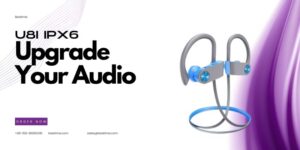
Driver size is a critical element in sound production, but it doesn’t work in isolation. The quality of sound delivered by earphones is the result of multiple interacting factors that enhance, balance, or limit the driver’s potential. Understanding these factors can help B2B clients make informed decisions when selecting earphones to meet their market needs.
Driver size interacts with acoustic design, diaphragm material, enclosure structure, and additional technologies like ANC to produce balanced and high-quality sound. These factors must be carefully tuned to complement the driver’s capabilities.
Let’s explore these factors in detail and their impact on audio performance.
Table of Contents
1. Acoustic Design: The Role of Chambers and Ports
The enclosure housing the driver, also called the acoustic chamber, plays a significant role in shaping the sound profile. Its design impacts how sound waves are managed and perceived.
How it interacts with driver size:
- Larger drivers: Need a larger chamber for optimal airflow and bass response. However, without careful tuning, they can produce boomy or muddy bass.
- Smaller drivers: Benefit from precision-engineered enclosures to enhance sound pressure and maintain clarity in mids and highs.
Acoustic Chamber Types
- Open-Back Designs: Allow air to flow freely, creating a natural and spacious soundstage, but at the expense of sound isolation.
- Closed-Back Designs: Seal the back of the driver to emphasize bass and improve sound isolation, commonly found in consumer-focused earphones.
Learn more about acoustic chamber design and its impact on sound1.

2. Diaphragm Material and Responsiveness
The diaphragm is a vital component within the driver, vibrating to create sound waves. Its material and responsiveness are critical for accurate sound reproduction.
Common Materials and Their Impact
| Material | Key Characteristics | Effect on Sound |
|---|---|---|
| Mylar | Lightweight and cost-effective | Balanced performance, common in most earphones |
| Titanium | High rigidity | Crisp highs and improved durability |
| Graphene | Lightweight and highly conductive | Enhanced sensitivity and detail |
| Beryllium | Extremely lightweight and rigid | Superior clarity and accuracy |
How it interacts with driver size:
- Larger drivers: Require sturdy materials to prevent distortion due to greater diaphragm movement.
- Smaller drivers: Rely on lightweight materials to achieve high-frequency precision and detail.
Discover more about diaphragm materials and their effects2.
3. Signal Processing and Sound Tuning
Modern earphones use advanced signal processing technologies to optimize sound, which can enhance or compensate for driver size limitations.
Signal Processing Technologies
- Digital Signal Processing (DSP): Adjusts frequencies and equalization to produce a balanced sound.
- Active Noise Cancellation (ANC): Cancels out ambient noise, ensuring the driver’s output remains clear.
- Audio Codecs: High-quality codecs like aptX and LDAC transmit more audio data, complementing the driver’s performance.
How it interacts with driver size:
- Large drivers: DSP can manage excessive bass, ensuring a balanced sound profile.
- Small drivers: DSP can amplify bass frequencies, compensating for their limited air movement capacity.
Explore signal processing technologies in earphones3.
4. Fit and Seal: Enhancing Perceived Sound Quality
Driver size impacts the earphone’s fit and the quality of the seal it can achieve, both of which influence sound perception.
How it interacts with driver size:
- Larger drivers: May make achieving a snug fit more challenging, potentially reducing sound isolation and perceived bass response.
- Smaller drivers: Fit more easily into the ear canal, often creating a better seal for passive noise isolation.
Learn about how fit and seal influence sound quality4.
5. Additional Features: Balancing Trade-offs
Modern earphones come equipped with features like multiple drivers, hybrid configurations, and wireless connectivity. These add complexity to the design and influence how driver size impacts sound.
Multiple and Hybrid Drivers
- Multiple Drivers: Allow specialization (e.g., one driver for bass, another for mids and highs), reducing the dependence on driver size for sound balance.
- Hybrid Drivers: Combine dynamic and balanced armature drivers to deliver both impactful bass and detailed treble.
How it interacts with driver size:
- With multiple or hybrid setups, even smaller drivers can deliver a full-spectrum sound by sharing the workload.
Wireless Technology
- Bluetooth Codecs: Premium codecs like LDAC ensure high-resolution audio, complementing the driver’s performance regardless of size.
- Low Latency Modes: Improve synchronization between audio and video, crucial for gaming and streaming.
Read more about additional technologies and their trade-offs5.
Conclusion
Driver size alone doesn’t define sound quality—it’s the synergy between driver dimensions and other factors like acoustic design, diaphragm material, signal processing, and fit that creates a superior audio experience. For B2B clients, understanding these interactions ensures they can choose earphones tailored to their target audience, whether prioritizing deep bass, clear treble, or overall sound balance.
Footnotes
- Insights into the role of acoustic chamber design in shaping sound.
- Explanation of how diaphragm materials influence driver performance.
- Overview of signal processing technologies and their interaction with driver size.
- Analysis of how earphone fit and seal affect sound perception.
- Discussion of additional features like hybrid drivers and wireless codecs.









